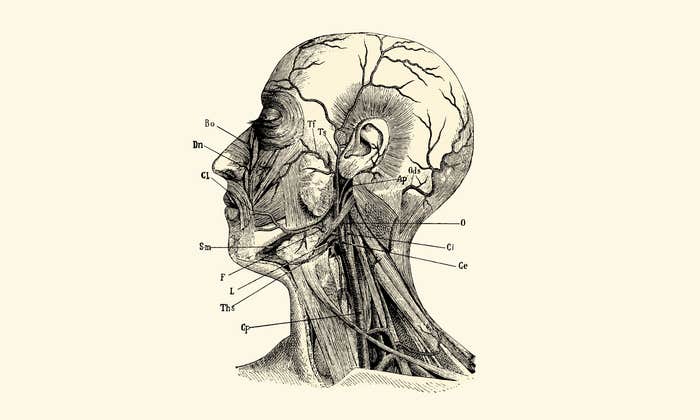In season 4 of The Sopranos, Tony is struggling to understand the birds and the bees. He’s having a hard time dealing with the fact that Valentina, the well-coiffed art dealer he’s currently chasing, is also dating his rival Ralphie. Tony can’t stand the idea of sharing a woman and tries to break it off, but Valentina assures him that Ralphie doesn’t like sex in the traditional way. So Tony asks his therapist if that could be true: “A guy like that is going out with a woman, he could technically not have penissary contact with her Volvo?”
Tony is not the only one confused about female anatomy and what to call it. A tangled web of taboo, ignorance, and linguistic confusion conspire to make many of us uncomfortable with saying words like “vagina” and “vulva” out loud. And even if we don’t have a problem with the words themselves, we often use them incorrectly, conflating the vagina—the muscular tube that connects the uterus to the outside—with the vulva. Meanwhile, everyday words for this region skew vague and euphemistic: think “nether regions,” “private parts,” or “down there.”
But we can at least take solace in the fact that our doctors know what they’re talking about. Right?
If I say I have pain in my elbow, my doctor shouldn’t think I’m referring to my shoulder.
Not exactly. It turns out doctors are not exempt from society’s general lack of understanding around this part of the body. And in medicine, the consequences of such linguistic murkiness can be far worse. Today, some anatomists and women’s health doctors worry that a lack of standard terms for the female genitals may be contributing to worse healthcare and a plethora of miscommunication in medical research—as well as making it harder for billions of women, trans men, and nonbinary people to understand and care for their own bodies.
At the center of the debate is the word vulva, an ancient term that today refers to the entire outer female genitals (you almost had it, Tony!). Though lesser used than vagina, the vulva is actually a more expansive landscape, encompassing the mons pubis, clitoris, inner and outer labia, and openings to the urethra and vagina. The word has taken off in recent years, in part because it highlights the outer genitals and separates them from the inner ones, helping us be more specific when we talk about our own anatomy.
Yet it turns out even vulva isn’t quite the linguistic savior we think it is.
At some point in medical school, doctors-in-training learn that vulva is the umbrella term for the external female genitals, and are shown a diagram of its major landmarks. But their education usually doesn’t go much deeper than that, says Maria Uloko, a urologist and vulva specialist at the University of California, San Diego. Besides a few specialized fellowships and continuing education classes, there is little formal training on the vulva beyond knowing, generally, where it is.
As a result, “We don’t think of it as a full structure, we just think of it as a sum of parts,” Uloko says.
In fact, the vulva is a unique, dynamic, medically important structure with a critical role in health. You might think of it as a tidal pool ecosystem: a motley crew of structures united by a shared capacity for change and adaptation. The vulva’s various parts must all contend with a dramatically changing landscape, responding to hormone tides, shifting microbial tenants, rising and falling acid levels, moisture fluctuations, and more. Together, they make up one of the body’s crucial barriers between you and not-you.
The vulva is also a powerful center of pleasure and sexual sensation—and, as many doctors and patients know, a site of potential pain and discomfort.
Doctors are not exempt from society’s general lack of understanding around this part of the body.
This region is central in a variety of common medical conditions, including urinary tract infections, painful skin conditions like lichen sclerosus, pelvic floor disorders, menopausal symptoms like vaginal dryness and irritation, and various genital cancers. Between 10 to 28 percent of people with this anatomy experience vulvar pain during their lifetime, and many wait years to get treatment. In the meantime, they are often redirected to psychological help or told to “have a glass of wine and relax,” as sexual health expert and urologist Rachel Rubin put it to the Washington Post.
This rather alarming state of medical ignorance isn’t that surprising. When it comes to the female body, medicine has long focused narrowly on the ability to become pregnant and bear children. “There’s a hyperfocus on reproduction and disease, but not actual quality of life,” Uloko says. That’s why medical students spend time learning about the ovulatory cycle and changes to the uterus during pregnancy—but not external components that contribute to protection and pleasure. “The emphasis is on internal structures,” agrees Jill Krapf, an ob-gyn and vulva specialist in Washington, D.C.
As a result, “there’s a general vagueness” around the vulva when it comes to medicine, says Uloko. But there may be another reason for the unbearable vagueness of vulva: a history of linguistic confusion stretching back millennia.
The term was once used far differently than it is today, says Matthew Zdilla, a clinical anatomist at West Virginia University who has been exploring the origins of vulva. His curiosity was first piqued after learning that it seemed to stem from the Latin for “to roll” (also the root word of the Swedish car brand Volvo, in a twist that somewhat vindicates Tony). In a field where most terms at least have a plausible origin story—e.g. the coccyx bone looked like the beak of a cuckoo, the Greek word for which was kokkyx—vulva “just made no sense,” says Zdilla, whose 2022 paper attempts to connect the linguistic dots.
In the earliest Western sources he could find, the word usually referred to the uterus—of a pig. The oldest known Roman cookbook, for instance, recommended seasoning sow “vulvae” with pepper, vinegar, and lovage, or coating it in bran and grilling it on the pan. Zdilla noted that a pig’s uterus, unlike a human’s, is fanlike and undulating, with distinct folds for each piglet to develop in. In other words, it does seem to “roll”—a clue, perhaps?
But the surprises kept on coming. A millennium later, the word cropped up in a more well-known Latin book: the Gutenberg Bible, first published in 1454. As it turns out, the world’s first mass-produced book is chock full of vulvas. However, “If somebody’s reading the Bible and they see vulva, it doesn’t mean what they think it means,” cautions Zdilla, whose years spent studying and teaching medical Latin were finally coming in handy. Once again, the word, usually spelled uulua or vulua, referred to the uterus—and sometimes, the uterus together with the vagina. In English, these all typically got translated into the nebulous womb.
So how did vulva emerge from denoting only internal parts, to being used solely for external ones? After the Gutenberg Bible, vulva rapidly blossomed to refer to anything and everything in the female genital area, from the cervix (the narrow bottom part of the uterus that connects to the vagina) to the space between the labia majora (sometimes called the pudendal cleft). To be fair, other terms were rapidly changing around this time, too: Nymphae, from the Latin for “bride” or “nymph,” at various points referred to the labia minora, clitoris, or the entire vulva.
It wasn’t until 1858 that the vulva definitively arrived at its current location. In that year’s edition of Gray’s Anatomy, Zdilla found a detailed diagram titled “The Vulva. External Female Organs of Generation.” The figure clearly labeled the mons pubis, clitoris glans, clitoral hood, labia majora, labia minora, urethra, “orifice of vagina,” and perineum (the area between the vaginal opening and the anus), along with a handful of curly pubic hair. Thanks to the widespread popularity of Gray’s, says Zdilla, this diagram likely helped codify the modern definition.

Somewhat. While the matter may have appeared settled, doctors of the time still had concerns. Given its baggage-laden past, might all the previous incarnations of vulva continue to muddy its definition and hamper its utility? That was the thinking of one gynecologist who, in 1882, declared vulva “about as devoid of strict scientific meaning as any anatomical term can well be.” If this word were not expelled from medicine, he cautioned, “There will be trouble with it otherwise until the end of time.”
Was that 19th-century doctor right? Does vulva have to go?
Ask an average women’s health care provider today to define the vulva, and they’ll likely do so with ease. But, oddly, their definitions don’t always line up—not exactly.
Among six vulva specialists I spoke with—two urologists and four gynecologists—there was striking disagreement on which structures are included in the vulva. (Note that vulva specialists as a group are ill-defined, but organizations like the National Vulvodynia Association estimate there are likely just a few hundred in the United States—for the 108 million adults in the country who have a vulva.)
Some believed the term included the entire clitoris, a deep structure that wraps around the vagina and urethra; others said only the glans clitoris, the visible part that is equivalent to the head of the penis. Some said the vulva included the hymen, a membrane remnant that can contribute to vulvar pain, while others considered that more of a boundary line between the vulva and the vagina.
The point of names in medicine is to facilitate communication and get providers and patients on the same page. If I say I have pain in my elbow, my doctor shouldn’t think I’m referring to my shoulder, or serious medical errors might result. While these nomenclatural quibbles may sound small, they point to a larger, more uncomfortable question: Does this word actually help us identify and treat this area of the body? If not, why are we holding on to vulva so tightly, anyway?
Krapf thinks the 19th-century physician calling for the field to retire vulva may have a point. In her mind, it never fully made sense to group the structures of the vulva together in the first place. (Which says a lot, coming from someone whose entire career revolves around this body part: “I look at the vulva all day every day,” she says.) It’s possible that vulva has become such a general, overarching term that it has eclipsed its components—and in many cases, prevented us from treating and studying each of its structures with enough care and attention.
Krapf notes several instances where it would help to refer to individual structures rather than the vulva as whole. First, the ring of skin that encircles the vaginal and urethral openings and lies between the labia, called the vestibule. (It is also the location of two sets of glands that contribute to lubrication and, possibly, protection from bacteria.) Once overlooked as just another part of the vulva’s ranging terrain, doctors have recently learned that the vestibule has remarkable and clinically important properties: It’s more similar to tissue of the bladder and urethra than the rest of the vulva, responds to testosterone more than estrogen, and is the site of up to 90 percent of vulvar pain.
When it comes to evaluating the actual source of pelvic pain, “It would be clinically beneficial to recognize the vestibule as distinct from the vulva and vagina,” says Krapf, who is co-author of the book When Sex Hurts: Understanding and Healing Pelvic Pain.
The world’s first mass-produced book is chock full of vulvas.
Another overlooked structure is the labia minora, or the inner lips of the labia. Given the way they’re often lumped in with the vulva, even doctors forget that they have a distinct function of their own: to protect the delicate glans clitoris and urethral opening and contribute to sexual arousal through their high blood flow and copious nerve endings. This lack of awareness may be why doctors often treat them with less care. Consider cosmetic labiaplasty, a procedure to trim the labia minora that has become one of the fastest-growing plastic surgeries. The procedure relies on the incorrect assumption that the labia perform no useful function and are just “extra skin”; in reality, removing them can lead to chronic pain, irritation, and loss of sensation.
Zdilla brings up a final problem: The inconsistent use of vulva in research papers can undermine doctors’ and scientists’ ability to communicate with each other. Scanning the recent medical literature, he found that some papers seemed to define the vulva as separate from the clitoris, perineum, or hymen. That meant that a researcher documenting the incidence of clitoral cancer would be stymied by the fact that “clitoral cancer” and “vulval cancer” are considered separate, despite the fact that the clitoris (or at least part of it) is reliably considered part of the vulva. This inconsistency makes it much harder to ascertain the true incidence of vulvar conditions.
Yet neither Krapf nor Zdilla are arguing that medicine should get rid of this term altogether. When it comes to communicating with patients, clinicians say vulva is still a valuable tool in their toolbox. “The definition is one thing, and then how it works clinically is another,” says Kiran Sigmon, an ob-gyn at Mission Hospital in North Carolina. In caring for her patients with pelvic pain, she often defines the vulva flexibly to include the possibility of pain or other conditions that radiate through the hymen, perineum, or even anus.
In the end, the lack of a standard definition for vulva is a window into a deeper problem: Thanks to a history of deep-seated bias in women’s health, the vagina and reproductive organs often get the spotlight, while the vulva is relegated to the background.
After all, it took until 2012 for the National Institutes of Health to establish a branch dedicated to general gynecology, as opposed to just fertility and infertility. Research on the vulva has similarly lagged behind. The clitoris, part of the body often seen as sexual rather than reproductive, wasn’t fully defined until 2005. Only last month did Uloko and her colleagues reveal how many nerve fibers innervate the clitoris—disproving the much-circulated 8,000 number, which stemmed from a 50-year-old study on cows. Besides holding the potential to improve sensation for phalloplasty patients and others who undergo genital procedures, their findings highlighted how little medical information actually exists on this part of the body.
Ultimately, changing the focus of women’s health—and in particular, acknowledging that comfort, pleasure, and sexual health matter at least as much as the ability to bear a child—will take more than changing terms. But what we can do, for now, is ensure that vulva has a clear, standardized meaning across medicine so that researchers, doctors, and patients can be sure they’re actually talking about the same thing. Both within and outside of medicine, terms like vulva help us expand our mental maps of our own bodies and shift the focus to broader notions of health and well-being, rather than just—as that 19th-century Gray’s Anatomy diagram put it—“generation.” ![]()
Rachel E. Gross is a science journalist and the author of Vagina Obscura: An Anatomical Voyage. She writes on reproductive health and bias in medicine for The New York Times, Scientific American, the BBC, and others.
Lead image: Oleg Senkov / Shutterstock


























